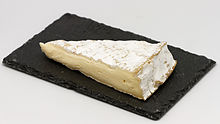Brush mold
| Brush mold | ||||||||||||
|---|---|---|---|---|---|---|---|---|---|---|---|---|

Penicillium chrysogenum |
||||||||||||
| Systematics | ||||||||||||
|
||||||||||||
| Scientific name | ||||||||||||
| Penicillium | ||||||||||||
| link |
Brush mold ( Penicillium ) ( Latin penicillus 'brush') is a genus of hose fungi from the Trichocomaceae family . The mushrooms are called brush mold because their conidia carriers together with the conidia look like brushes. Species in this genus are important in the production of both penicillin and foods such as mold cheese .
features
The thallus , the mycelium of the brush mold, consists of a strongly branched network of multinucleated hyphae, divided by septa and mostly colorless . On this hyphae mycelium the typical multi-branched conidia carriers with the individually constricted conidiospores form , which represent the main form of distribution of the fungi and are mostly green in color.
Through sexual reproduction, the mushrooms also form typical fruiting bodies that contain the ascospore . The process of sexual reproduction begins with the wrapping of an ascogonium and an antheridium , during which the cell nuclei are exchanged . Then, through the connection of hyphae, the fruiting bodies with the randomly distributed asci are formed . Each ascus contains eight unicellular ascospores.
Way of life

Brush molds live mainly in the cool and temperate climates as widespread soil fungi and are therefore present almost everywhere where organic material is produced for degradation. The saprophytes among the brush molds and the watering can molds Aspergillus species are among the best-known representatives of the Eurotiales and live mainly on organic, degradable substances. They represent the classic molds and are among the most important food spoilers. Many species secrete mycotoxins , which are highly toxic.
Economical meaning
A number of brush molds play a central role in the production of cheese as well as various meat products. For example, Penicillium camemberti and Penicillium roqueforti are used as noble molds in the production of Camembert , Brie , Roquefort and many other types of cheese. In the raw sausage and ham production, mushrooms such as Penicillium nalgiovense are used, which on the one hand improve the taste and on the other hand increase the shelf life by preventing colonization with other types of fungi.
In addition to the species used in the food industry, brush molds are a source for the biotechnological production of enzymes such as pectinases , lipases , amylases , cellulases and proteases, as well as watering can molds ( Aspergillus ) . They are also used to produce important organic acids, especially citric , gluconic and tartaric acids . In addition, important antibiotics are obtained , among which penicillin and griseofulvin in particular play an economic role.
Types (selection)
The following list presents some relevant species of the genus Penicillium :
- Penicillium aurantiogriseum
- Penicillium brevicompactum
- Penicillium camemberti ; is used as a noble mold in cheese production.
- Penicillium digitatum
- Penicillium chrysogenum ( Syn . : Penicillium notatum ); is used to manufacture the antioxidant erythrobic acid and the antibiotic penicillin .
- Penicillium citrinum ; compactin , the first statin , wasisolatedfrom this
- Penicillium commune
- Penicillium corylophilum
- Penicillium crustosum
- Penicillium cyclopium
- Penicillium expansum ; Very potent degradation fungus that can also decompose leather, paints and minerals with the help of various enzymes and acids, brown rot pathogen .
- Penicillium funiculosum
- Penicillium glabrum
- Penicillium glaucum ; is used as a noble mold in cheese production.
- Penicillium griseofulvum ; is used to manufacture the antibiotic griseofulvin .
- Penicillium italicum
- Penicillium marneffei
- Penicillium nalgiovense ; is used as an inoculation agentin the production of raw sausage and ham.
- Penicillium nordicum
- Penicillium palitans
- Penicillium purpurrescens
- Penicillium purpurogenum
- Penicillium olsonii
- Penicillium roqueforti ; is used as a noble mold in cheese production.
- Penicillium variabile
- Penicillium viridicatum
- Penicillium verrucosum ; Field and storage pests with high production of toxic mycotoxins, especially ochratoxin and citrinin .
literature
- Martin Schmiedeknecht: Eurotiales in: Urania plant kingdom . Viruses, bacteria, algae, fungi. Urania-Verlag, Berlin 2000; Pages 417-418. ISBN 3-332-01167-7 .
- Wolfgang Mücke, Christa Lemmen: Molds. Occurrence, health hazards, protective measures. ecomed MEDIZIN, Landsberg am Lech 2004
Web links
- FungiQuest - Fungiscope Query Tool
- Penicillium Genus Record in the Index Fungorum
